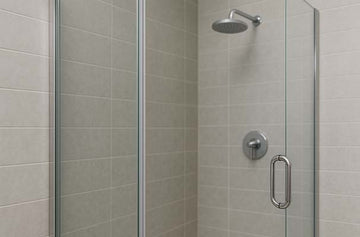
The leaky shower door is not a mere nuisance as the water coming out of the enclosure may damage floors, encourage moulds and spoil the clean and contemporary appearance of a glass shower.
We will discuss the main causes of shower door leakage, assist you in understanding the precise location of water intrusion, offer the best sealing strategies, (such as frameless shower seal, shower PVC seal and other measures), provide you with a step-by-step repair process, and conclude with the preventive maintenance measures so that you can keep your bathroom consistently waterproof..
Common Causes of Shower Door Leaks

Poor or worn seals
The seals that are placed into the edges of the shower doors break down with time, get brittle, warped or misaligned. Specifically, PVC seals or vinyl/silicone seals can lose their elasticity or have tears. As soon as the seal is broken, water is able to leak out through minute holes.
Wrong junctions between glasses to glasses or to walls
In frameless or semi-frameless construction, panels intersect either on sides, or on the wall. Provided that those junctions are not perfectly flush or the corresponding seal profiles are not installed correctly or are absent, water can by-pass it.
Lack of slope or threshold design
Unless the base or tray on which the shower is situated is inclined properly (i.e. with a slight inclination towards the inside) or the threshold (lip) is too low, the water may splash out instead of being directed inside the tray.
Loopholes in the door (bottom sweep problems)
The bottom sweep or floor seal which is in the bottom or under the door is one of the most common problem areas. In case it is short, misaligned or not there, the water sprays out of the bottom.
Hinges Have misaligned or worn doors
The door hinges especially shower hinges used on glass shower doors, may be misaligned or worn.
When the door is not plumb (it drifts or sags), the seals will not fit properly, creating gaps that lead to air or water leaks.
Inappropriate installation or inferior quality of work
Leaks Sometimes such leaks are caused by installation errors: the wrong type or size of seal, or ragged cut edges, or careless sealing at corners and joints.
Wearing of adhesive or caulking
When silicone or sealant is applied (between glass and wall or in corners) it is prone to shrink, crack or lose its adhesion - leaving water with an escape route.
Knowing which of these is your problem is the important thing - and the following section can help you to identify which it is systematically.
What to do to determine the source of the leak.
Identifying the point of water leakage will assist you to select the appropriate repair instead of replacing all seals without any insight. Here's how to pinpoint it:
Step A: Observation of leakage pattern.
Turn on the shower and look where the water is dripping, is it dripping on the bottom, or spurting out of a side seam, leaking around a corner or at a corner with the glass to the wall meeting. The location gives clues.
Step B: Tissue or blotting paper.
As the shower is running, take a piece of tissue or a towel and run it along the probable joints (top, sides, bottom) to determine where the moisture is being transferred.
Step C: Trim test (intercept test)
To prevent the passage of one joint at a time, some workers will just place a thin piece of tape or paper along the affected joint, until the leakage pattern changes, the suspect seam is identified.
Step D: Evaluate seals, boundaries and surfaces.
Check every seal, bottom sweep, and edge visually to determine if they have been damaged, cracked, have become warped or have gaps. Tolerances of check spaces (thickness of glasses, thickness of doors-to-walls) are accurate.
Step E Check door alignment and swing.
Make sure that door closes level, the hinges are tight and up to date and there is no droop. Test the verticals with a straightedge or spirit level.
Step F: Test using little water.
Isolate sections after identifying your areas of leak: pour water slowly in the places you think leak (e.g. with a cup) to determine whether you have a leak.
After finding the area of trouble(s), the appropriate sealing solution can be selected as follows.
Most Effective Sealers to Frameless (and Other) Shower doors
It does not have a universal solution - the optimal solution will be determined by the type of door you have, the thickness of the glass, the size of the gaps at the doors, and your aesthetic tastes. The best sealing tactics are the following:
Bottom Sweep / Door Seal (PVC, vinyl, silicone)
It is a piece of plastic material that is put on the bottom of the edge of the shower door and brushes against or touches the threshold to prevent water.
· Shower PVC seals are usually hard and tough yet affordable.
· Flexible or vinyl seals have a superior conforming over uneven surfaces.
· Silicone sweeps are high quality products- they are more resilient and less affected by hard water.
Note that you need to ensure that the sweep is the same thickness as your glass (e.g. 6 mm, 8 mm, 10 mm) and that the leg of the seal is sufficiently long to extend to the tray. Quality Glass Fittings distribute several types of shower seal strips in accordance with the thickness of the glass.
These types of seals are designed to attach securely to vertical or angled edges of frameless or semi-frameless shower doors:
- H-jamb seals (H profile): Commonly used for inline doors or glass-to-glass connections at 180° angles, offering strong water resistance at jointed panels.
- Y-jamb seals: Slim-profile fin seals ideal for narrow or tight gaps where minimal material is desired without compromising sealing strength.
- C-channels or U-channels: These slide directly over the glass edge, providing a solid guide for seal placement or serving as a mounting base.
Magnetic Sealing Strips
For shower doors that meet in the middle — such as pivot doors, bi-fold configurations, or glass-to-glass edge doors — magnetic strips are an effective solution. These create a tight bond when the doors close, instantly sealing the joint and preventing water leakage
Our magnetic sealing options at Quality Glass Fittings are specially designed for frameless shower systems, ensuring a sleek finish with powerful magnetic closure. These strips not only improve water resistance but also enhance the overall aesthetics and functionality of your shower door setup.
Silicone rubber caulking and sealant.
Caulk with high grade Bathroom silicone to seal the gaps between the glass and wall or fill corners. The mould-resisting flexible bathroom grade sealant should always be chosen. It is necessary to use it with sparingly and due caution in order to avoid influencing the operation of the doors.
Combination systems
In many cases a combination of seals is the most appropriate solution - e.g. bottom sweep and side jamb and magnetic strip and caulk. Both of them serve to push the water back into the shower.
Correct profile selection
Pick seals that were intended to be used out of doors (exposed to the water), stable and tolerance. Quality Glass Fittings has several profiles and lengths that are used in the showers. (Quality Glass Fittings LTD)
Considering the types of right seal and by matching them with accuracy to the geometry of the door, you can produce a strong waterproof sealing.
For a more modern and functional bathroom, explore the stylish range of shower handles from Quality Glass Fittings
Shower Door Leaks- How to Repair.
The following is a handy repair procedure that one can implement after determining the sources of the leakages and the type of seals to use:

Tools & materials you'll need
- Measuring tape / callipers (to measure the thickness of glass and gaps between the glass)
- Marker or pencil
- Fine-tooth hacksaw, plastic, pipe cutter or seal-cutting tool.
- Soft cloth / microfibre
- Mild glass cleaner
- Silicone sealant of bathroom quality.
- Rubber mallet (not necessary, cloth cushion may be used)
- Replacement sweep, jambs, magnetic strips etc.
- Masking tape
- Cleaning alcohol/solvent Isopropyl alcohol.
Procedure
Remove old seals carefully
Or very carefully remove existing sweeps or seal strips. When they get stuck, moisten them with warm water or a light solvent (check compatibility).
Glass edges and glass surfaces are clean
Erase the adhesive residues, soap scum or silicone residues. Apply light cleaner/isopropyl alcohol, and dry it.
Measure carefully
Measure: thickness of glass, size of the vertical gaps, distance between bottom and threshold, seal lengths required.
Cut seal material
Then with your measurements cut the new seal strips in a straight line. Best results should be achieved with fine-tooth saw or plastic cutter.
Dry-fit before insertion
Install the seals loosely in place and then final install them to make sure they are correctly aligned and that all is not twisted or misplaced.
Fitting bottom sweep / door seal
So that the bottom sweep, with its seal in contact with the threshold, or tray, reflects the water inwards. Tap lightly with rubber mallet (inclusion of cloth).
Installation of magnetic strips -side / jamb
Add angular or vertical seals. Magnetic strips must be placed in a manner such that when the doors are shut they fit in a tight manner.
Seal glass-to-wall joints
At the area where the glass touches the tiled wall or any other fixed wall, place a thin layer of silicone sealant. Cut edges of the mask and make smooth using a finger or a tool and leave to cure (usually 24 hours).
Test the seal
Wait until sealant has completely drying up. Then pour the shower and check whether leaks are present. Test drip points with the help of tissue or blotting. Move or change seals in case of slight leakage.
Make minor adjustments
In case of leakages, you can always substitute with a thicker leg sweep, realign or add seal to the junctions.
With these steps, you will be in a position to systematically repair most of the shower door leaks..
Maintenance Preventive

Some routine maintenance and inspection will help a lot in order to provide two or more years of leak-free performance. The preventive measures include:
Clean seals weekly: Seals are worn off by soap scum and mineral deposits. Wipe them with nonabrasive, light cleanser and soft cloth.
Inspect seals for wear: Examine cracks, brittle nature, staining, or warping on a regular basis (after several months). Any weakened seal should be replaced.
Avoid harsh chemicals: Abrasive scouring pads and strong acids are not to be used. They destroy the material and reduce the life of seals.
Lubricate magnetic strips: Wipe magnets periodically to remove debris in order to be attracted with cleanliness and establish a good contact.
Re seal silicone joints: In case of cracking or shrinking of corner silicone beads, clean off, put on full bead to ensure water tightness.
Monitor door alignment: Should hinges become loose during their service, tighten them to ensure doors should always contact seals flush against the doors.
Use a squeegee: Following every shower, a squeegee is used to minimize the size of water droplets flowing into crevices and corners.
Ensure proper ventilation: Good ventilation means the condensation and stress on seals is minimized and increases their life.
Replace seals proactively: Although complete failure may not have occurred, it is good to change seals after every 1-3 years based on the use and quality of the water used. PVC seals are more likely than silicone to age.
Conclusion
Leaking shower door is one such issue that can easily be solved. With some knowledge on the usual culprits of shower door leaks, identifying the source of the exact leak, and determining the appropriate sealing elements (bottom sweeps, side jambs, magnetic strips, high quality frameless shower seal or shower PVC seal), you will be able to regain the waterproof integrity of your bathroom. The step by step guide will assist you in performing repairs are best and clean and routine preventive maintenance will ensure that the seals are in good condition over the years.

